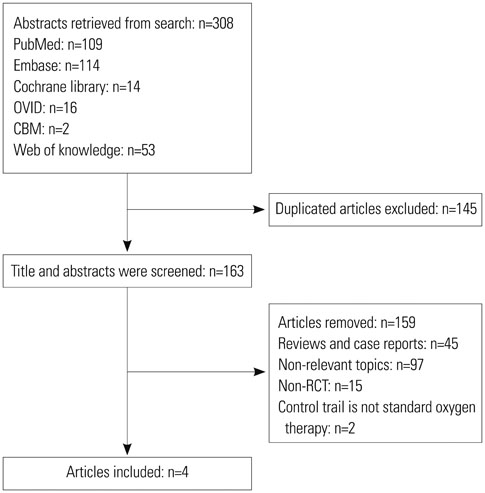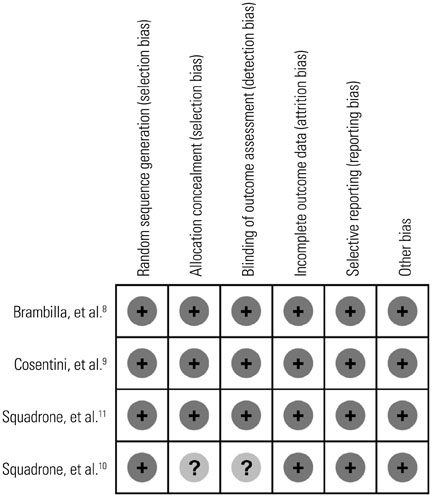Yonsei Med J.
2016 Jul;57(4):936-941. 10.3349/ymj.2016.57.4.936.
Helmet CPAP versus Oxygen Therapy in Hypoxemic Acute Respiratory Failure: A Meta-Analysis of Randomized Controlled Trials
- Affiliations
-
- 1Department of Respiratory Medicine, Zhujiang Hospital, Southern Medical University, Guangzhou, China. chen_xin1020@163.com
- 2The State Key Laboratory of Respiratory Disease, Guangzhou Institute of Respiratory Disease, Guangzhou Medical University, Guangzhou, China.
- KMID: 2374126
- DOI: http://doi.org/10.3349/ymj.2016.57.4.936
Abstract
- PURPOSE
The efficacy of helmet continuous positive airway pressure (CPAP) in hypoxemic acute respiratory failure (hARF) remains unclear. The aim of this meta-analysis was to critically review studies that investigated the effect of helmet CPAP on gas exchange, mortality, and intubation rate in comparison with standard oxygen therapy.
MATERIALS AND METHODS
We performed a meta-analysis of randomized controlled trials (RCTs) by searching the PubMed, Embase, Cochrane library, OVID, and CBM databases, and the bibliographies of the retrieved articles. Studies that enrolled adults with hARF who were treated with helmet CPAP and measured at least one of the following parameters were included: gas exchange, intubation rate, in-hospital mortality rate.
RESULTS
Four studies with 377 subjects met the inclusion criteria and were analyzed. Compared to the standard oxygen therapy, helmet CPAP significantly increased the PaO2/FiO2 [weighted mean difference (WMD)=73.40, 95% confidence interval (95% CI): 43.92 to 102.87, p<0.00001], and decreased the arterial carbon dioxide levels (WMD=-1.92, 95% CI: -3.21 to -0.63, p=0.003), intubation rate [relative risk (RR)=0.21, 95% CI: 0.11 to 0.40, p<0.00001], and in-hospital mortality rate (RR=0.22, 95% CI: 0.09 to 0.50, p=0.0004).
CONCLUSION
The results of this meta-analysis suggest that helmet CPAP improves oxygenation and reduces mortality and intubation rates in hARF. However, the significant clinical and statistical heterogeneity of the literature implies that large RCTs are needed to determine the role of helmet CPAP in different hypoxemic ARF populations.
Keyword
MeSH Terms
Figure
Reference
-
1. Esquinas Rodriguez AM, Papadakos PJ, Carron M, Cosentini R, Chiumello D. Clinical review: helmet and non-invasive mechanical ventilation in critically ill patients. Crit Care. 2013; 17:223.
Article2. Mehta S, Hill NS. Noninvasive ventilation. Am J Respir Crit Care Med. 2001; 163:540–577.
Article3. Hillberg RE, Johnson DC. Noninvasive ventilation. N Engl J Med. 1997; 337:1746–1752.
Article4. Mas A, Masip J. Noninvasive ventilation in acute respiratory failure. Int J Chron Obstruct Pulmon Dis. 2014; 9:837–852.5. Delclaux C, L'Her E, Alberti C, Mancebo J, Abroug F, Conti G, et al. Treatment of acute hypoxemic nonhypercapnic respiratory insufficiency with continuous positive airway pressure delivered by a face mask: a randomized controlled trial. JAMA. 2000; 284:2352–2360.
Article6. Nava S, Navalesi P, Gregoretti C. Interfaces and humidification for noninvasive mechanical ventilation. Respir Care. 2009; 54:71–84.7. Crimi C, Noto A, Princi P, Esquinas A, Nava S. A European survey of noninvasive ventilation practices. Eur Respir J. 2010; 36:362–369.
Article8. Brambilla AM, Aliberti S, Prina E, Nicoli F, Del Forno M, Nava S, et al. Helmet CPAP vs. oxygen therapy in severe hypoxemic respiratory failure due to pneumonia. Intensive Care Med. 2014; 40:942–949.
Article9. Cosentini R, Brambilla AM, Aliberti S, Bignamini A, Nava S, Maffei A, et al. Helmet continuous positive airway pressure vs oxygen therapy to improve oxygenation in community-acquired pneumonia: a randomized, controlled trial. Chest. 2010; 138:114–120.
Article10. Squadrone V, Massaia M, Bruno B, Marmont F, Falda M, Bagna C, et al. Early CPAP prevents evolution of acute lung injury in patients with hematologic malignancy. Intensive Care Med. 2010; 36:1666–1674.
Article11. Squadrone V, Coha M, Cerutti E, Schellino MM, Biolino P, Occella P, et al. Continuous positive airway pressure for treatment of postoperative hypoxemia: a randomized controlled trial. JAMA. 2005; 293:589–595.
Article12. Cammarota G, Vaschetto R, Turucz E, Dellapiazza F, Colombo D, Blando C, et al. Influence of lung collapse distribution on the physiologic response to recruitment maneuvers during noninvasive continuous positive airway pressure. Intensive Care Med. 2011; 37:1095–1102.
Article13. Higgins JP, Altman DG, Gøtzsche PC, Jüni P, Moher D, Oxman AD, et al. The Cochrane Collaboration's tool for assessing risk of bias in randomised trials. BMJ. 2011; 343:d5928.
Article14. Lau J, Ioannidis JP, Schmid CH. Quantitative synthesis in systematic reviews. Ann Intern Med. 1997; 127:820–826.
Article15. Higgins JP, Thompson SG, Deeks JJ, Altman DG. Measuring inconsistency in meta-analyses. BMJ. 2003; 327:557–560.
Article16. Fasano L, Mega C, Pisani L, Navalesi P, Bellone A, Scala R, et al. Efficacy of helmet as interface for noninvasive ventilation (NIV) in acute hypercapnic respiratory failure (AHRF). Chest. 2012; 142(4_MeetingAbstracts):946A.
Article17. Antonaglia V, Ferluga M, Molino R, Lucangelo U, Peratoner A, Roman-Pognuz E, et al. Comparison of noninvasive ventilation by sequential use of mask and helmet versus mask in acute exacerbation of chronic obstructive pulmonary disease: a preliminary study. Respiration. 2011; 82:148–154.
Article18. Chiumello D, Esquinas AM, Moerer O, Terzi N. A systematic technical review of the systems for the continuous positive airway pressure. Minerva Anestesiol. 2012; 78:1385–1393.19. Nava S, Hill N. Non-invasive ventilation in acute respiratory failure. Lancet. 2009; 374:250–259.
Article20. Lindner KH, Lotz P, Ahnefeld FW. Continuous positive airway pressure effect on functional residual capacity, vital capacity and its subdivisions. Chest. 1987; 92:66–70.
Article21. Principi T, Pantanetti S, Catani F, Elisei D, Gabbanelli V, Pelaia P, et al. Noninvasive continuous positive airway pressure delivered by helmet in hematological malignancy patients with hypoxemic acute respiratory failure. Intensive Care Med. 2004; 30:147–150.
Article22. Brett A, Sinclair DG. Use of continuous positive airway pressure in the management of community acquired pneumonia. Thorax. 1993; 48:1280–1281.
Article23. L'Her E, Deye N, Lellouche F, Taille S, Demoule A, Fraticelli A, et al. Physiologic effects of noninvasive ventilation during acute lung injury. Am J Respir Crit Care Med. 2005; 172:1112–1118.24. Nava S, Carlucci A. Non-invasive pressure support ventilation in acute hypoxemic respiratory failure: common strategy for different pathologies? Intensive Care Med. 2002; 28:1205–1207.
Article25. Tonnelier JM, Prat G, Nowak E, Goetghebeur D, Renault A, Boles JM, et al. Noninvasive continuous positive airway pressure ventilation using a new helmet interface: a case-control prospective pilot study. Intensive Care Med. 2003; 29:2077–2080.
Article26. Pang D, Keenan SP, Cook DJ, Sibbald WJ. The effect of positive pressure airway support on mortality and the need for intubation in cardiogenic pulmonary edema: a systematic review. Chest. 1998; 114:1185–1192.
Article27. Keenan SP. Noninvasive positive pressure ventilation in acute respiratory failure. JAMA. 2000; 284:2376–2378.
Article28. Chiumello D, Pelosi P, Carlesso E, Severgnini P, Aspesi M, Gamberoni C, et al. Noninvasive positive pressure ventilation delivered by helmet vs. standard face mask. Intensive Care Med. 2003; 29:1671–1679.
Article29. Antonelli M, Pennisi MA, Pelosi P, Gregoretti C, Squadrone V, Rocco M, et al. Noninvasive positive pressure ventilation using a helmet in patients with acute exacerbation of chronic obstructive pulmonary disease: a feasibility study. Anesthesiology. 2004; 100:16–24.
Article30. Patroniti N, Foti G, Manfio A, Coppo A, Bellani G, Pesenti A. Head helmet versus face mask for non-invasive continuous positive airway pressure: a physiological study. Intensive Care Med. 2003; 29:1680–1687.
Article
- Full Text Links
- Actions
-
Cited
- CITED
-
- Close
- Share
- Similar articles
-
- Comparison of Respiratory Effects of Continuous Flow CPAP System with Demand Flow CPAP System
- High-Flow Nasal Cannula Oxygen Therapy Can Be Effective for Patients in Acute Hypoxemic Respiratory Failure with Hypercapnia: a Retrospective, Propensity Score-Matched Cohort Study
- Short Segment versus Long Segment Pedicle Screws Fixation in Management of Thoracolumbar Burst Fractures: Meta-Analysis
- Vitamin D and Risk of Respiratory Tract Infections in Children: A Systematic Review and Meta-analysis of Randomized Controlled Trials
- Prophylactic efficacy of probiotics on travelers' diarrhea: an adaptive meta-analysis of randomized controlled trials







